Getting to the Bottom of SPICECOREResearchers drill deep into the ice beneath the South Pole to sample Earth’s ancient atmospherePosted April 12, 2016
As the winch extracted a two-meter-long cylinder of ancient ice in late December, Murat Aydin looked on. 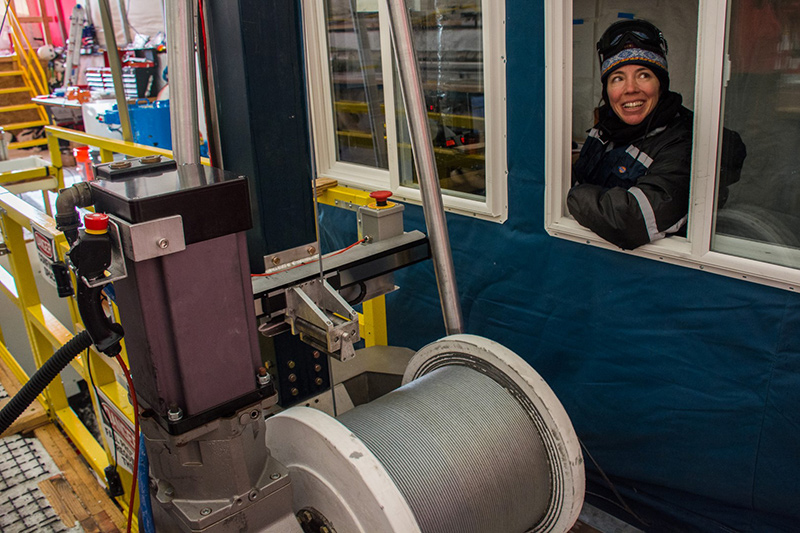
Photo Credit: Mike Lucibella
Shawntel Stapleton operates the drill that’s boring into the ice under the South Pole.
“If we can keep this pace up we should be able to hit 1,600 meters,” he said. “This is going to be the deepest ice core drilled at the South Pole by quite a margin.” By the end of the project a month later, researchers with the South Pole Ice Core project, known more succinctly as SPICECORE, had exceeded even their most ambitious goals. Aydin is an atmospheric chemist at the University of California, Irvine and the lead scientist on SPICECORE. The project wrapped up its two-year drilling effort at the South Pole in late January, having collected ice samples from 1,751 meters (5,744 feet) below the surface, more than 200 meters (656 feet) deeper than the original goal. 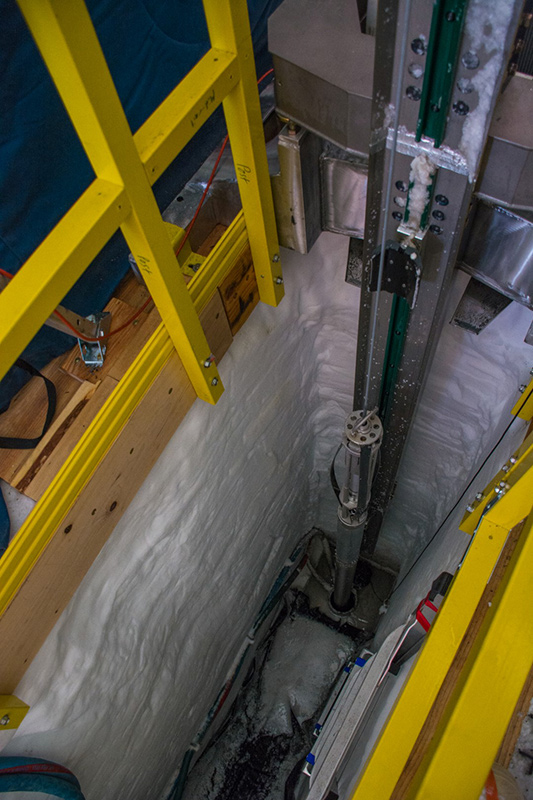
Photo Credit: Mike Lucibella
The SPICECORE drill hauls up an ice core from hundreds of feet below the surface.
“There is no better feeling for a field scientist than coming back home, having surpassed all expectations,” Aydin said. SPICECORE is supported by the National Science Foundation, which manages the U.S. Antarctic Program. These ancient ice samples are important to climate scientists because sealed inside each ice core are numerous tiny air bubbles, which are essentially samples of atmosphere from before the ice was completely buried. Scientists analyze these trapped bubbles to learn what the Earth’s atmosphere was like thousands of years ago. These measurements have become a key tool for climate researchers investigating ancient carbon dioxide levels to better understand the planet’s present warming trends. Though much ice core trace gas research focuses on gleaning insight into ancient carbon dioxide and methane levels, the SPICECORE research will also focus on a different class of gases found at much lower levels in the atmosphere. Measurements of rare gasses like carbonyl sulfide, methyl chloride and methyl bromide offer further details about how the trace gas composition of the atmosphere changed over thousands of years and what impacts the changes in global biogeochemical cycles may have had on it. The ice started out as accumulated snow at the surface. Each year a new layer of snow builds up on top of the layer laid down the previous year. The weight of all this extra snow compresses the frozen snowflakes together until they fuse and become solid ice. The farther down into the ice sheet the team drills, the older the ice gets. The samples nearest to the bottom could be as many as 50,000 years old. 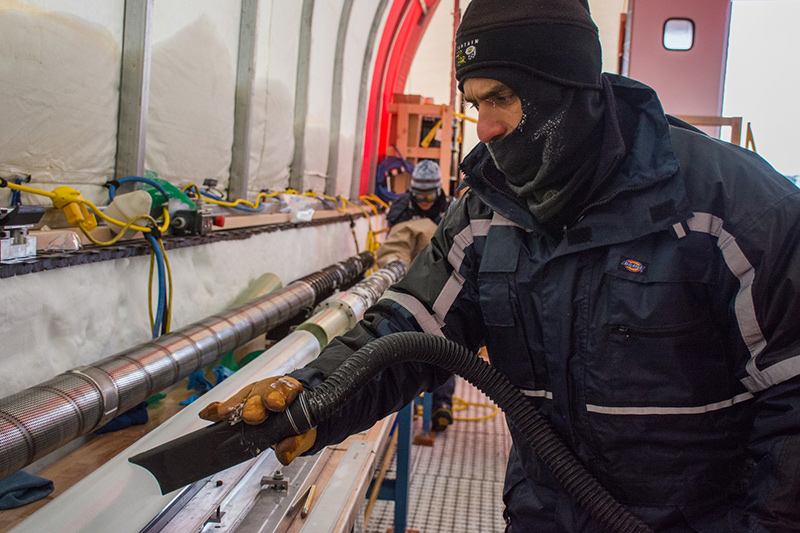
Photo Credit: Mike Lucibella
Murat Aydin cleans cutting fluid off of a recent ice core as he prepares it for storage.
Setting up shop next to the South Pole station is ideal for the team in part because the station can provide logistical support that would otherwise have to be established for an isolated field camp. Drilling at the South Pole also helps fill in some of the gaps in the scientific record around the continent. “If you look at all the other ice cores drilled in East Antarctica, they’re kind of far away, so there isn’t a lot from this region of East Antarctica, climate record wise,” Aydin said. In addition, the station’s location atop the frigid polar plateau is a boon for collecting atmospheric samples. “We wanted an East Antarctic ice core because of the temperatures,” Aydin said. “The ice is a lot colder here, because the annual mean temperature is about minus 50 [Celsius]. For some of the gas measurements we make, colder ice is better.” 
Photo Credit: Mike Lucibella
Shawntel Stapleton cleans and prepares the ice drill for another run. The team was drilling 24 hours a day.
But on the flip side, the temperatures that help with the science can wreak havoc on the equipment. “The ice here, because it’s colder, it’s also harder,” said Jay Johnson, a mechanical engineer at the University of Wisconsin, Madison’s Ice Drilling Design and Operations (IDDO). “Last season we had a lot of problems with [drill] bits chipping and cracking corners off and things like that, so we had to go to a different process of heat treating the metal this year and that’s working much better.” Johnson is one of the chief designers of the drill boring through the ice. The Intermediate Depth Drill (IDD) the IDDO developed is based on an existing Danish drill design called the Hans-Tausen drill but with some modifications. The idea was to develop a design with standardized parts that could be shared between both programs. “This might be one of the first times that has happened internationally,” Johnson said. “That was one of the goals of that too, so we could have some interchangeability between the two countries’ systems.” One of the main changes the IDDO made to the original Danish design is that they used fiberglass to make their outer core barrel, the part of the drill bit that’s lowered into the hole and sheathes the ice sample while it’s brought back to the surface. “We were able to make these tubes for about ten times cheaper than you can make them out of metal,” Johnson said. “They’re straighter, more round and run more true. They’re probably a little more disposable, probably a little shorter life span maybe than stainless [steel], but the benefit is that they’re extremely cost effective.” 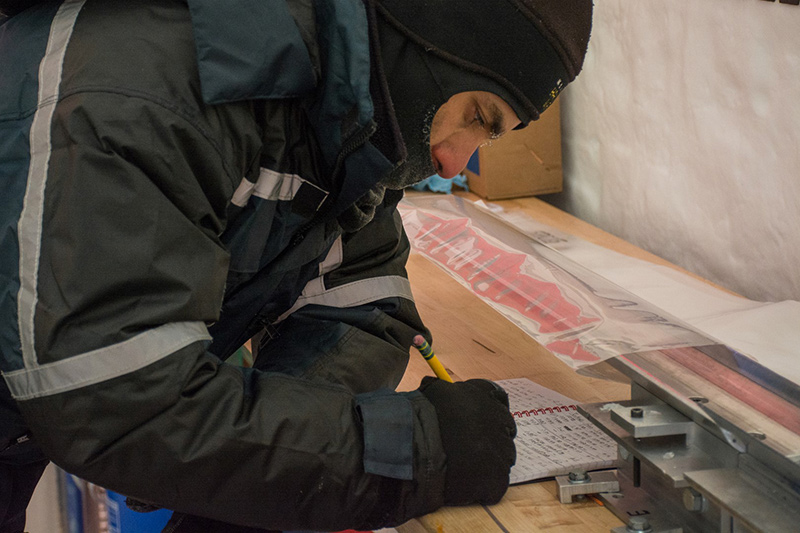
Photo Credit: Mike Lucibella
Murat Aydin jots down information about the last ice core he processed.
This South Pole ice coring operation is the first run of the new IDD. It was designed to fill a gap in drilling capabilities between small ice coring drills that can only penetrate about 300 meters (about 980 feet) into the ice, and much larger operations like WAIS Divide that can bore down several thousand meters. “This is one that had been in the works for a number of years,” Johnson said. “The U.S. science community wanted this intermediate depth drill for lighter logistics and easier transportability.” By reducing the amount of support that the drill needs, the system can be deployed more quickly and cheaply than other, larger drills. “We designed this project to be quick, efficient and get the biggest impact for the buck,” Aydin said. “Let’s get the most valuable science out of it with the smallest footprint possible.” 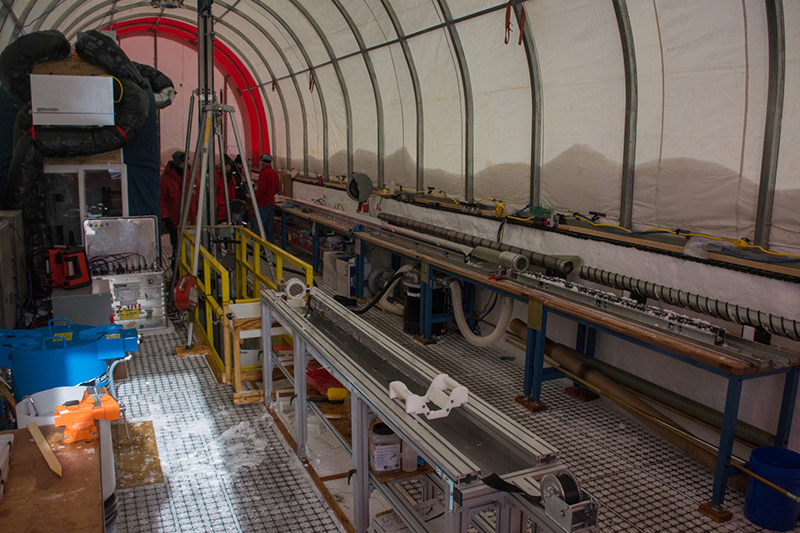
Photo Credit: Mike Lucibella
SPICECORE's Intermediate Depth Drill was designed to have a smaller footprint than larger ice drilling projects like WAIS Divide.
Because of its smaller size, the IDD can’t reach all the way to bedrock nearly three kilometers (1.8 miles) below the surface of the ice. However the lowest layers under the Pole are not ideal ice samples, because the ice that the South Pole rests on is constantly flowing at a rate of about 10 meters (30 feet) a year. “The ice that we find at South Pole didn’t originate here… the deeper you go, the farther away it’s coming from,” Aydin said. “It complicates the interpretation of the isotope record, especially the deeper sections.” Aydin will return to the South Pole next season to close out the project. The drilling is finished, but the camp still needs to be disassembled. There are also samples that remained behind that need to be packed up and shipped to the National Ice Core Laboratory (NICL) in Denver where cores from previous years are already stored. “It's a great feeling but I don't feel like it is all over,” Aydin said. “It is just starting in a way because we have all this beautiful ice to analyze now. Making good measurements and publishing interesting papers are the next targets now.” In the lab, Aydin works to identify and characterize the rare trace gasses trapped in the ice. In addition, scientists from around the world will be able to process and analyze the core samples stored at the lab for their own projects. “There are many measurements that are going to be made and there are different institutions that are going to be involved,” Aydin said. “When all is said and done, there’s going to be plenty of South Pole ice there for years to come at NICL.” NSF-funded research in this story: Murat Aydin, University of California-Irvine, Award No. 1142517 |



For USAP Participants |
For The Public |
For Researchers and EducatorsContact UsU.S. National Science FoundationOffice of Polar Programs Geosciences Directorate 2415 Eisenhower Avenue, Suite W7100 Alexandria, VA 22314 Sign up for the NSF Office of Polar Programs newsletter and events. Feedback Form |


